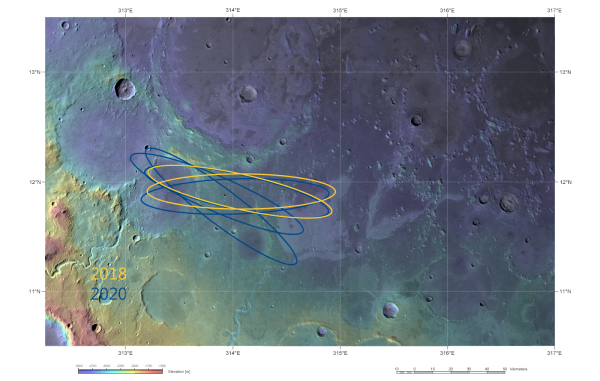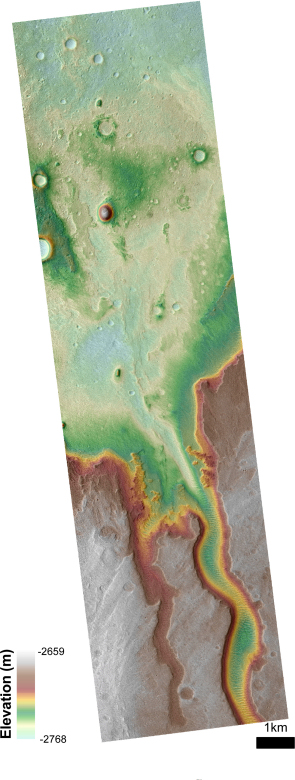Hypanis Vallis
(Hypanis Vallis was one of four candidate landing sites that were studied for the ExoMars 2018 mission. It was downselected at the Third Landing Site Selection Workshop. The sites that are being studied for the ExoMars 2020 mission are Aram Dorsum, Mawrth Vallis, and Oxia Planum.)
The proposed site at Hypanis Vallis (11.9°N, 314°E) is located in the Xanthe Terra region, on the south-western margin of Chryse Planitia, near the major highland-lowland boundary.
 |
| ExoMars landing ellipses in Hypanis Vallis. Credit: ESA/DLR/FU Berlin & NASA MGS MOLA Science Team |
Hypanis Vallis is one of several valleys situated between two large outflow channels, Maja Vallis in the west and Shalbatana Vallis in the east. These valleys are deeply incised into the ancient Noachian plateaus, which were created some 4 billion years ago, have more or less constant widths, and possess few tributaries. They display amphitheatre-shaped valley heads, with some evidence for small shallow valleys connecting to these head scarps. At least one of these valleys (Nanedi Vallis) contains an inner channel.
 |
| Detail of region in Hypanis Vallis. Credit: NASA/MRO/HiRISE/Hypanis Vallis Team/LSSWG |
The valleys are thought to have been formed by groundwater seepage or surface runoff. Several of the valleys, including Hypanis Vallis, have fan-shaped deposits at their termini. These fluvial deposits are interpreted as the remnants of a delta that formed in a lake. They are characterised by distinct layering at their margins, providing access to the various sedimentary layers.
No chemically altered minerals have been identified so far within the landing ellipse, which has a major-axis of 104 km and minor-axis of 19 km. However, hydrated minerals have been detected in nearby outcrops. The site also offers access to exhumed sedimentary rocks of Early Hesperian age (3.45 billion years old).
The elevation is fairly constant across the landing ellipse, although the deposits form several lobes, the margins of which appear to be eroded, with layering clearly visible in the steep cliffs (scarps). Some inverted channels seem to be associated with the fan-shaped deposits. The surrounding plains are relatively smooth and do not display any noticeable textural peculiarities.
The landing ellipse is not directly located on the fan deposits, but lies in a region where very fine-grained materials may have been deposited. Isolated, kilometre-sized hills with rounded shapes suggest that the entire area has been exhumed. Irregular pitted cones in the nearby Lederberg crater may be of igneous volcanic origin.
The regional crater counts suggest that several resurfacing events took place since the original highland unit formed about 4.1 billion years ago. The fan sedimentary deposits appear to have been exposed, at most, for the last 800 million years, with the loss of smaller craters due to dune activity or other Aeolian (wind-blown) sedimentation.
This landing site has high potential for having hosted microbial life and for preserving its biosignatures. If life emerged in the area, its traces could be found in the fine-grained sediments that were derived from material eroded from the cratered highlands to the south.
Finer particles would have been carried northward, where the proposed landing site is located. If the sediments were formed in a standing body of water, then this aqueous environment would have been directly habitable and traces of life may be recorded in the strata exposed in the deposits.
The location of this sedimentary material at the margin of Chryse Planitia implies that the delta could have formed in a large body of water that existed in the planet’s huge northern lowland basin. Thus, the investigation of these sediments would also test the hypothesis that Mars once possessed a northern ocean.
Even if life did not emerge locally, the longevity of the standing body of water would have allowed sufficient time for viable cells to be transported there. Biosignatures, in the form of fossilised structures and/or organic remains, could be present. The degree of degradation of these biosignatures would depend on how long ago the area was exhumed.
Further details about the landing site selection process can be found in the report of the Landing Site Selection Working Group: Recommendation for the Narrowing of ExoMars 2018 Landing Sites.



